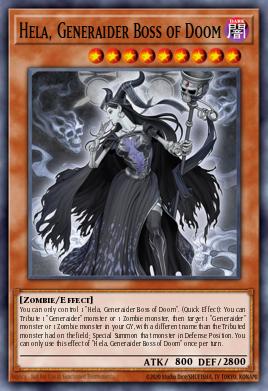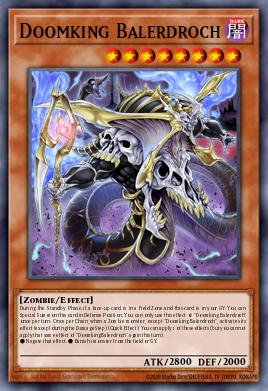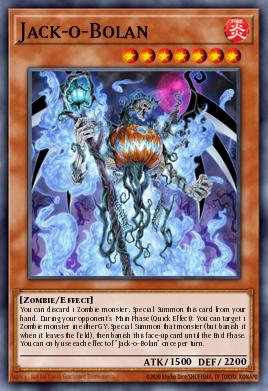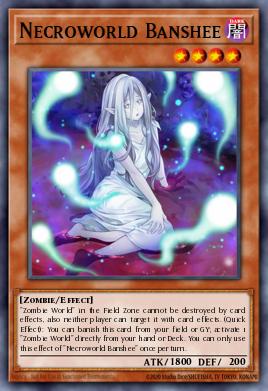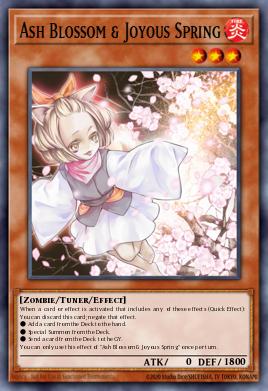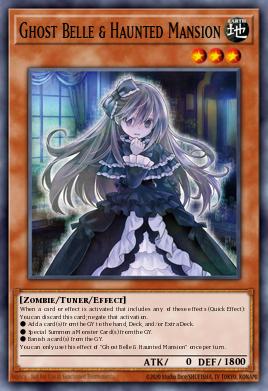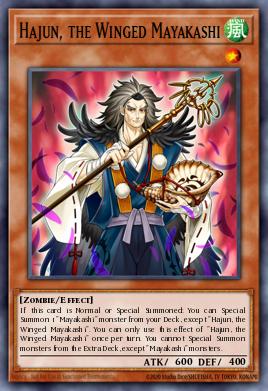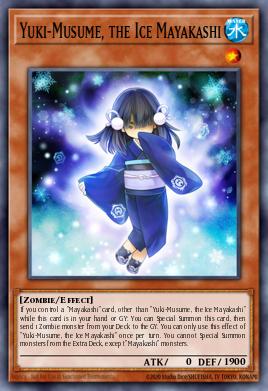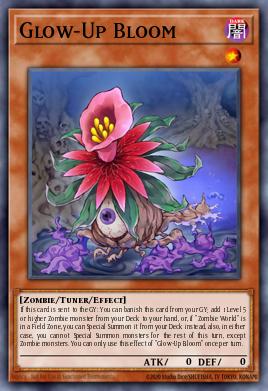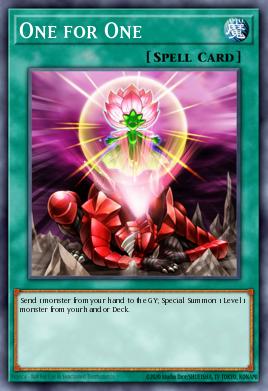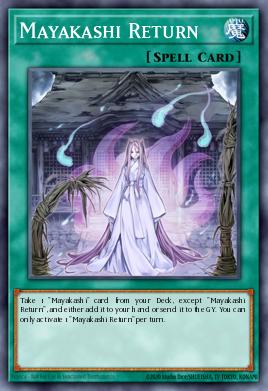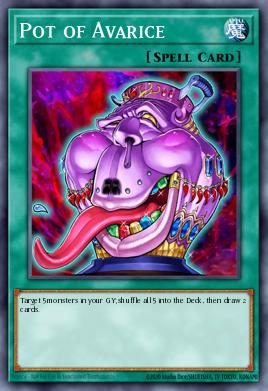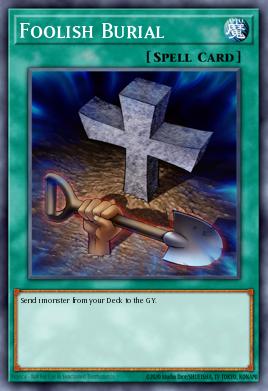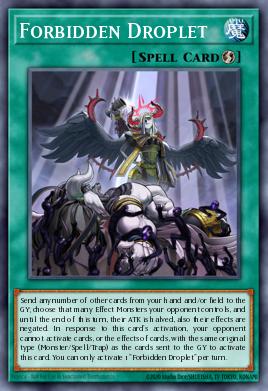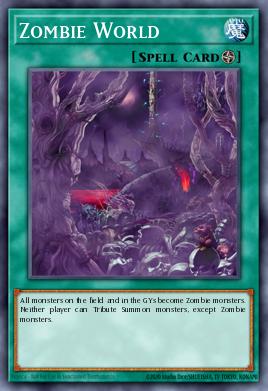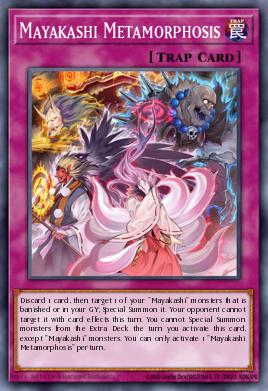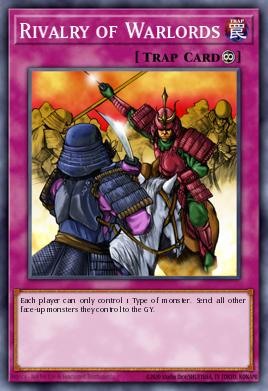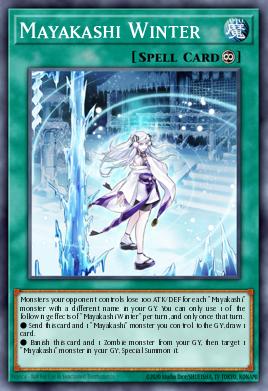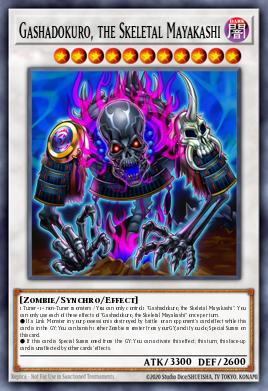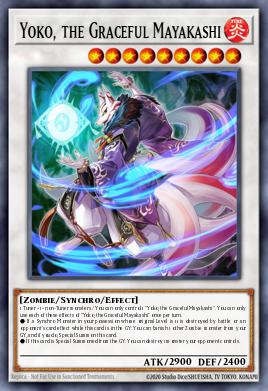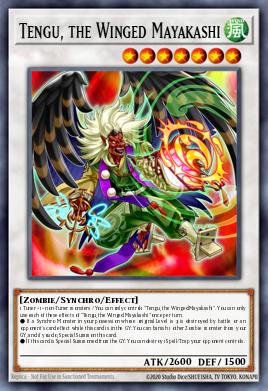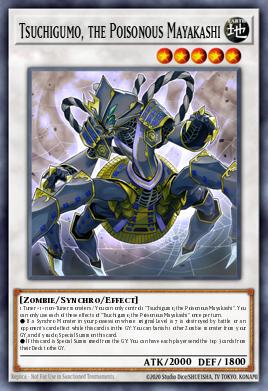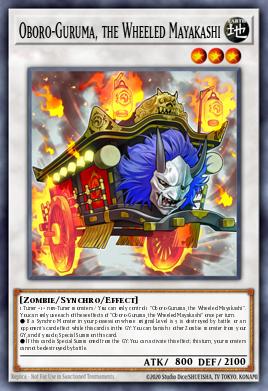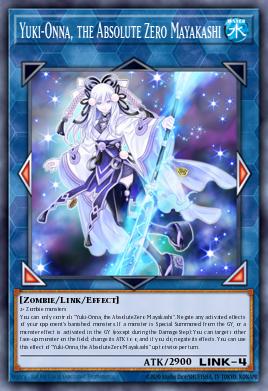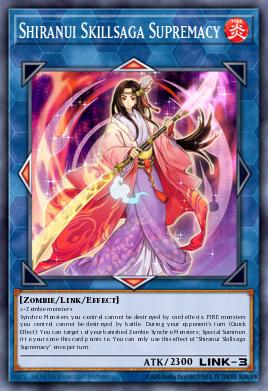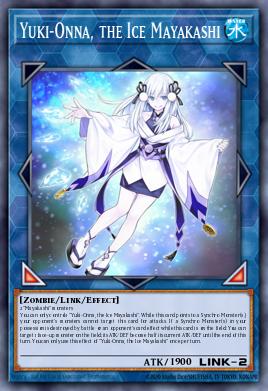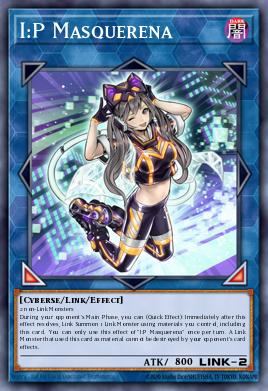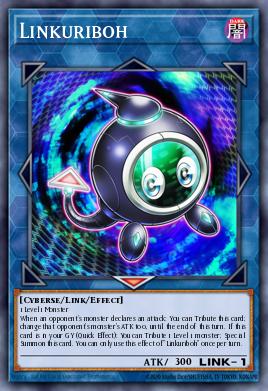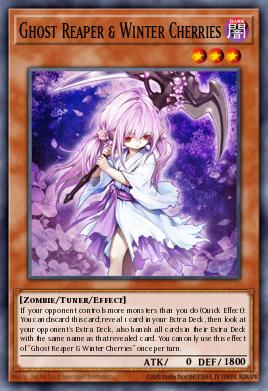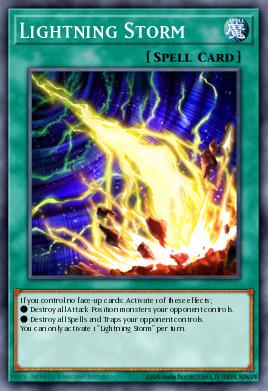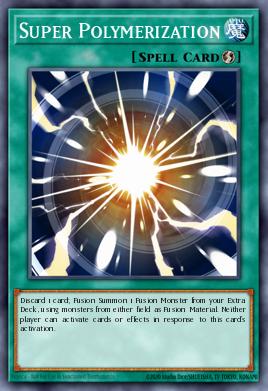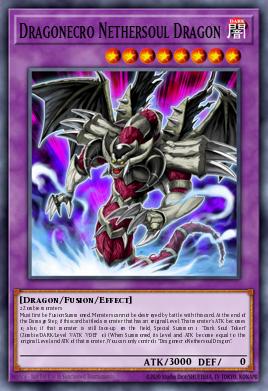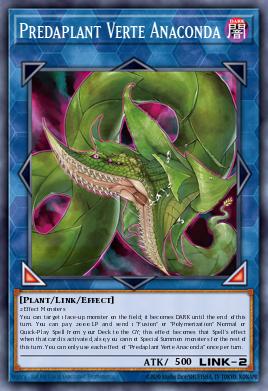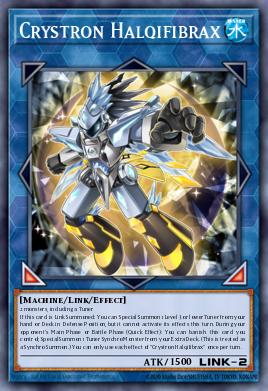Deckbox of the Dammed Presents: Mayakashi Midrange
Deck Primer
Deck Box of the Dammed presents: Mayakashi Midrange
1) Deck Box of the Dammed: an intro
2) Decklist and Tech Choices.
3) Combos and Follow-Up Plays
4) Final Thoughts
1. Welcome to the Deck Box of the Dammed: An Intro to the Authors and Archetype
Welcome all lost souls to the Deck Box of the Dammed, with a ghoulish list courtesy of the twisted mind of Jazzy_Sue. This list of spectres and skeletons is so terrifying that your opponent won’t stand a ghost of a chance. I myself have suffered horrifying defeats at the hands of this list, and as such decided that I’d put out a guide for the Halloween season. This list brings you all the terror of the monstrous Mayakashi archetype, a collection of spirits based on Japanese yōkai. These spirits are in perpetual conflict with the demon-hunting Shiranui archetype, however they have agreed to put aside their conflict for the sake of this list. Aside from them we also have a variety of zombie favourites and tech choices to bring you all the terror of Halloween right from the comfort of your own haunt.
2. Deck-list and Tech Choices
Main-deck Mayakashi and Miscellaneous Zombies
Dakki, the Graceful Mayakashi x 3
We begin with the deck’s hyper-extender and the primary set-up tool of the Mayakashi archetype. Dakki is a real force to be reckoned with; as long as your starting hand has Dakki or one of the many ways to find her you are pretty much guaranteed to climb through all of the Mayakashi synchros and some of the links as well. This is due to Dakki’s effect laughing in the face of popular interruptions such as Nibiru or Infinite Impermanence, thanks to it being a Trigger Effect that activates in the graveyard. The one downside to Dakki is her permanent xeno-lock effect: as long as her effect activates you will be locked into Mayakshi extra deck monsters for the rest of the turn, even if she leaves the field. We run this at three to boost the consistency of the deck’s most resilient hand (mentioned at length in the Combo Guide) but running two is acceptable if you’re tight on main-deck space.
Hajun, the Winged Mayakashi x 3
Hajun functions as the deck’s primary starter next to Glow-Up Bloom, searching either Dakki or Yuki-Musume on summon. It should be noted that the effect triggers on any sort of summon, so One for One is a direct 4th copy of Hajun. Along with Mayakashi Return this boosts the consistency of opening Hajun or a way to search it to 58%, a respectable average for any starter. It should again be mentioned that Hajun xeno-locks you into Mayakashi extra deck monsters, although unlike Dakki as long as you can link-off Hajun the effect is not continuous. We play three copies of Hajun here for consistency of our main combo, but you can experiment with less if you’d like to try other starters.
Yuki-Musume, the Ice Mayakashi x 3
As the last of the main deck Mayakashi monsters, Yuki-Musume fills the final role as an advantage generator. It functions as a once-per-turn Foolish Burial for any zombie monster as long as it’s in your hand or graveyard and you control a Mayakashi monster. Since this lets you foolish any zombie we can preform lines with Glow-Up Bloom if we drew Zombie World or lines with Necroworld Banshee if we did not. Both of those option leave us with full Mayakashi combo plus at least Zombie World and potentially Balerdroch for the negate and banish. For these reasons we play three; you can experiment with less but it will directly effect your resource loop’s consistency.
Doomking Balerdroch x 2
At last out of the main-deck Mayakashis we come to the Zombie World portion of the deck, starting with its boss Doomking Balerdroch. You have several ways of getting to Balerdroch — chiefly Glow-Up Bloom — but honestly anything that gets it in the grave works fine as long as you or your opponent controls a field spell. Once on field Balerdroch represents a banish or negate that is triggered by any zombie effect anywhere, including the hand. This allows clever plays with our hand-traps of choice or our opponents’ depending on the meta. Balerdroch represents an additional recursive body for link climbs on your turn, and often this looping of monsters is enough to overwhelm your opponent in conjunction with the aforementioned banish-and-negate plus your innate Mayakashi effects from the grave. We play two because its very searchable and easy to Foolish, plus it tends to brick at three.
Jack O’Bolan x 2
Another stop on the standard Zombie-deck express, Jack O’Bolan is a fantastic way to unclog bricky hands. You can discard a variety of things to summon him — ideally Balerdroch or Glow-Up Bloom — but there are as many options as there are zombies that plus in the grave. It can be funny and devastating to use his effect in conjunction with Zombie World to steal your opponents’ destroyed monsters, only to link them off and have it banished when it leaves the field. Due to his convenient level he can also help jump-start your Mayakashi lines with Dakki into Yoko, the Graceful Mayakashi (more on this in the Combo Guide). Overall he’s worth running at two but considering he can searched off Glow-Up Bloom, any more would bloat the deck.
Hela, Generaider Boss of Doom x 1
So here’s a fun one, Hela is not the best in her own archetype but here she synergizes amazingly. We summon her off of the same fundamental Glow-Up Bloom line we summon Balerdroch with, so she’s not exactly a rare sight. Her effect lets us not only get rid off Yuki-Mususme or Balerdroch for advantage, but also summon any zombie we want in our grave. This can be used on your opponent’s turn in order to generate interruptions in the form of the Mayakashi synchro monsters’ on-summon effects, such as Yoko’s pop or Tengu’s backrow disruption. Of course, doing this is also an excellent way to trigger Balerdroch’s banish proactively to shut down your opponent’s plays. We only play one copy of Hela due to Glow-Up Bloom ratios but more could be an option. Perhaps you could experiment with a greater Generaider package as none of our xeno-locks stop us summoning from deck.
Glow-Up Bloom x 3
We’ve already talked at length about the uses of Glow-Up Bloom so I won’t belabour the point too much. Glow-Up Bloom is an auto-include in anything playing Balerdroch in my opinion. It can be bricky, but we have an out to that (see Combo Guide). It’s obviously most powerful when Zombie World is on the field, but even adding a zombie to hand can secure a follow-up play for next turn. We would honestly run four if we could! Feel free to experiment with you own ratios, but be prepared for the cohesiveness of your build to suffer.
Necroworld Banshee x 2
So in a deck that depends on its field spell for interruption and recursion, are you really going to turn down extra copies of Terraforming? We don’t play three due to it being highly searchable with most of your standard lines, and it clogging up the deck’s valuable normal summon in the hand. Feel free to experiment with this slot; the ratios are up to preference and how much you value Zombie World in the current meta.
Mezuki x 1
We end the monsters on a truly classic zombie: Mezuki has been a staple in Zombie World lists since its release. In this deck it’s there to help extend and insulate your lines against hand-traps due to the myriad of ways to Foolish zombies in the deck. You don’t really want to see Mezuki in the opener without Jack O’Bolan or another way to discard for cost, so we choose to run one. You could experiment with more and maybe even a copy or two of Gozuki and Shiranui Solitaire if you value extension.
Spells and Traps
Mayakashi Return x 3
We start the spell and trap section with a huge consistency booster in Mayakashi Return. It searches or Foolishes all of the Mayakashis, most importantly Hajun in the event you don’t have Yuki-Musume in your opener. It can also be used to extend with Yuki-Mususme if you drew Dakki and Hajun. Additionally, Return can be used to search all the Mayakashi Spells and Traps. Overall I think this card is an auto-include at three in any Mayakashi build for how much it boosts the consistency of your lines.
Mayakashi Winter x 1
I’ll be honest, Winter is pretty bad. Its first and second effect are largely irrelevant in this build, but we play it for its graveyard effect. It allows us to convert an extra Mayakashi Return into a potential pop for monsters, spells, or traps depending on the contents of your graveyard. This can also be used to further your OTK lines on the crack-back. You could cut this in favour of another Monster Reborn-style effect if you think it would synergize better with your build.
Mayakashi Metamorphosis x 2
Metamorphosis is our best Reborn option. It not only summons but also provides protection from targeting and a discard, which can unbrick cards like Yuki-Musume or Mezuki from your hand. Obviously you can search it with Return as with all Mayakashi cards, boosting the consistency of seeing it. The key use of this card is summoning your synchros on your opponent’s turn to interrupt their combos with a well-placed pop or mill. You can absolutely fiddle with the ratios of this one, although we like it at two as it complements the above-mentioned Winter and Return nicely.
Zombie World x 3
Zombie World has a storied history of meta and off-meta play over the years; it remains a rogue-tier strategy in many tournaments to this day. This list’s use of the card focuses on its type-changing effect to lock your opponent out of summoning with Rivalry of Warlords. There are several ways to search this card including Terraforming and the aforementioned Necroworld Banshee, which can be Foolished as a part of your opening combo using Yuki-Musume if you don’t have need of her other targets. We have experimented with running Set Rotation and Magical Mid-Breaker Field to boost the consistency of Zombie World and shut down your opponent’s use of field spells and ability to target. It might be worth experimenting with if you’re so inclined, otherwise just play three.
Terraforming x 1
There’s not much need to explain this one. Terraforming is a fourth copy of Zombie World and potentially more if you run the Set Rotation combo mentioned above. We’ve discussed using Metaverse as well, but ultimately we felt it wasn’t worth the extra card.
Rivalry of Warlords x 3
Here we come to the most crucial half of the eponymous Rivalry lock. In conjunction with Zombie World, you can lock your opponent out of summoning anything other than zombie monsters. This disrupts the majority of current strategies aside from Eldlich (as of Oct. 2020) and makes up a large part of how this list deals with higher-tier opponents on the play. Balerdroch can be helpful for keeping the lock on field for longer with his recursive negate, along with any of your Mayakashis graveyard effects. I would say that any rogue-tier or below zombie deck should be playing Rivalry, but if you dislike locks feel free to switch these for more handtraps.
One for One x 1
Another format staple, One for One is an additional copy of Hajun that can plus you depending on what you discard. Obviously we want to play as many consistency boosters for our starter as possible, so I wouldn’t consider this slot mutable if you want to run the lines we do (see Combo Guide). It being a special summon from deck also opens up explosive lines with certain main-deck Mayakashi monsters. If for some reason this ever gets off the limited list, run as many as you can.
Foolish Burial x 1
I’ve referenced this card several times as a catch-all for any effect that sends cards from the deck to the graveyard. Obviously in a zombie deck this card is near-mandatory in my opinion as it sets up Yuki-Mususme or Mezuki for set-up or extension respectively. Most of the time you’ll be sending Yuki-Musume to either set up Necroworld Banshee or Glow-Up Bloom for Balerdroch. Overall an amazing card; as with One for One, if it ever gets unlimited we’ll be playing more.
Pot of Avarice x 2
Pot of Avarice is pretty broken in Midrange. It’s especially relevant here since we are trying to dump a minimum of six optimal targets on the first turn (based on any hand with Hajun or access to him). From there Avarice is basically a Pot of Greed that refreshes your deck and allows you to synchro climb again. We only play two due to space constraints in this build, but three is a valid option — feel free to experiment.
Forbidden Droplet x 3
We finish off the Spells and Traps section with the format-staple board-breaker Forbidden Droplet. We play it here as an out to the various Towers most decks are playing, and as a tool for simplifying boards going second. The discard for cost is obviously helpful here as we have monsters and spells that plus in the graveyard: Winter or Yuki-Musume for example. The slot could also be used for Super Poly — you’ll see below that we side it, but if you prefer it then feel free to take this out. I would caution that extra deck space is tight, so this will be a little more consistent.
Handtraps and The Side Deck
Notes on The Side and format techs
Before I start on the hand-traps we play in this list I’d like to go over Jazzy_Sue’s position on the side deck’s use. They believe the side deck should be used to patch up holes in the deck’s capabilities: as an example we play Lightning Storm in the side to help with the Mayakashis’ lack of bulk removal for spells or traps. You are welcome to play whatever you personally think is relevant, or just stick with our list. It wasn’t made with any particular tournament in mind so some fine-tuning would be wise if you intend to play this list in one.
Ash Blossom and Joyous Spring x 3
Ash is not a particularly strong hand-trap in a vacuum in my opinion due to its lack of destruction, but as a compliment to other disruption it can shut down a wide array of plays. In this list, that other disruption is normally some combination of: Rivalry, Zombie World or Balerdroch. The last is especially relevant as Ash is a zombie and can therefore trigger Balerdroch’s effect to banish natively whenever your opponent searches. If you’re particularly attached to another option for this slot, feel free to switch it out at the cost of some synergy.
Ghost Belle and Haunted Mansion x 3
This pick is slightly more useful in this particular build, as it allows us to protect the one resource that really matters: the graveyard. Due to the toolbox style of the Mayakashis’ on-summon effects, banishing from the grave is devastating for our lines and interruption. Since the effect can be used on both graveyards there are a fair number of decks that don’t like to see this card. Ghost Belle’s effect will also trigger Balerdroch due to Ghost Belle being a zombie like Ash. Feel free to try other options in this slot, we mostly run it due to it being Jazzy_Sue’s favourite hand-trap.
The Extra Deck
Oboro-Guruma, the Wheeled Mayakashi x 1
We begin our look at the extra deck with the worst Mayakashi synchro. Oboro-Guruma is almost entirely here to help with dumping our synchros in the grave on turn one. Once he’s in the grave, Oboro-Guruma is most useful as a banish target to trigger your other Mayakashi synchro’s summon-from-the-grave effects. The battle protection can be useful as a last-ditch stall in a pinch, I guess. You really can’t play less of this if you want the first-turn combo to work properly but play more if you value battle protection.
Tsuchigumo, the Poisonous Mayakashi x 1
Tsuchigumo is another not-great extra deck pick we play to assist with our initial climb. The mill effect on summon can potentially be useful for setup if you hit the right cards or in very grindy match-ups. This one is also a good banish for other stronger Mayakashi summons on your opponent’s turn. I would recommend running one of these for the sake of your first-turn play. but running any more is probably unnecessary as there are better uses for extra deck space.
Tengu, the Winged Mayakashi x 2
Finally we come to a good Mayakshi synchro, Tengu being the first that we want to special summon on our opponent’s turn. When summoned this way Tengu pops an opponent’s spell or trap, allowing you to take out problem cards like like Dragunity Divine Lance or Dragon Buster Destruction Sword and allowing you to shut off your opponent’s combos or locks. Since the effect activates on the field it’s still vulnerable to Mystic Mine, but there are side deck options to compensate for this. We run two Tengu in this build in response to the current popularity of decks like Sky Striker, Salamangreat, and Monarchs. As mentioned above this is to out various back-row locks and combo pieces; if back-row becomes less prevalent then I’d recommend playing one of these.
Yoko, the Graceful Mayakashi x 2
Yoko is by far the best Mayakashi extra deck monster, just like its main-deck counterpart Dakki. Its on-summon effect is a non-targeted pop of any monster, which is certainly worth the two extra slots it takes up. This will form the backbone of your active disruptions, as aside from the pop Yoko is also blessed with a reasonable attack stat of 2900. This often allows it to clean up your opponent’s simplified boards the turn after it was special summoned. As an aside you don’t even have to climb into Yoko through the normal line as it can be summoned with just a Jack O’Bolan and Dakki; this is often how you start lines in situation where you don’t draw Hajun (see Combo Guide 3). Overall Yoko is a very worthwhile card to run in any Mayakashi build, although due to how tight the extra is we wouldn’t recommend running it at three.
Gashadokuro, the Skeletal Mayakashi x 2
We end our look at the Mayakashi synchros with Gashadokuro, who notably has the second highest attack of any zombie-type synchro monster. Aside from being a formidable beatstick he is also unaffected by card effects the turn he is summoned from the grave by any effect. This can assist with clearing lower-attack threats and finishing your opponent on the follow-up. This all said Gashadokuro’s primary use in this build is in the grave as protection of sorts for your link monsters, as your opponent may not want to waste valuable removal on a problem card like Yuki-Onna, the Absolute Zero Mayakashi or I:P Masquerena when a Towers with high attack is lurking in your grave. All this said I think you could probably get away with playing one of these in favour of the above-mentioned third Yoko, if you want more focus on disruption.
Yuki-Onna, the Ice Mayakashi x 2
As with the above synchros our first link is more of a name than anything else. We play two Yuki-Onna, the Ice Mayakashi to aid in clearing our main-deck Mayakashi xeno-lock on the follow up play, mainly Yuki-Musume and Hajun. Her effect can be handy in a pinch but mostly we use her to climb into Shiranui Skillsaga Supremacy and the other Yuki-Onna for more effective disruption. You could play less of this but it would hamper your follow-up plays and restrict your ability to play non-zombie links.
Yuki-Onna, the Absolute Zero Mayakashi x 2
The second Yuki-Onna is much more impactful than its link two counterpart. Its a twice-per-turn permanent effect negate any time a monster activates its effect in the grave, like all of our aforementioned Mayakashi synchro monsters. If you’re starting to notice powerful synergy then welcome to the disruptive centre of the deck. Our first turn aims to end on this plus the Zombie World/Rivalry lock and Balerdroch at minimum, which leaves us with two permanent effect negates, a monster effect negate, and the Rivalry lock. This is more than enough to stop most tier two and below decks in their tracks, although it can struggle with more meta relevant decks’ almost-infinite extension. A last funny note on Yuki-Onna, the Absolute Zero Mayakashi is that its first effect hard-counters banish-heavy decks like Thunder Dragon so long as it’s on field. We play two as to allow us to repeat our climb if we need to as link fours tend to attract negates, but you could cut this to one in favour of more non-zombie links or Cherries targets.
Shiranui Skillsaga Supremacy x 1
At last we come to the last Zombie link and the first non-Mayakashi extra deck monster. Anyone who’s played Zombie World decks before is likely familiar with the Shiranui archetype, or at the very least Shiranui Solitaire. Luckily for any of you new to this deck, Shiranui Skillsaga Supremacy doesn’t have much to do with his archetype’s gimmick beyond summoning any of your banished zombie monsters. The primary use of this is to recycle high-impact synchros like Tengu and Yoko to allow you to out tempo your opponent over longer match-ups. As a fun secondary bonus if you summon Yoko, Skillsaga’s first effect will protect it from destruction and allow for a follow-up into Yuki-Onna, the Absolute Zero Mayakashi on your turn. We only play one of these as the long games where this card shines are increasingly rare in the Oct 2020 format. That said, if the meta slows down in future more of these could be worth experimenting with.
I:P Masquerena x 1
Now on to the non-zombie link monsters, and I know that might sound odd in a lock-based zombie deck but I’ll explain. There are a couple scenarios we run into commonly that necessitate that we link off our monsters to further our plays, without being under Rivalry or the innate xeno-lock of the main-deck Mayakashis. Masquerena is mostly for getting synchros in the graveyard and has the added benefit of allowing us to go into a link three or four with extra protection using our spent Mayakashis on our opponent’s turn. You could easily cut this in favour of another link two like Vampire Sucker or such but we think Masq has the most impact.
Linkuriboh x 1
As mentioned above our non-zombie links are for resolving niche board states, this time with our main-deck Mayakashi. Linkuriboh is for linking off a negated Hajun in the event we don’t have Yuki-Musume. As a bonus this one can also be used to get your follow-up Yuki-Musume (or Glow-Up Bloom in a pinch) into the grave for recursion and link material. This was an addition based on how many decks are playing Infinite Impermanence and Effect Veiler; it comes up relatively often and at least gets us something interactive on board. If you’d like to cut this you can, I don’t think there are many other link ones that would work but go ahead if you disagree.
3. Combo Guide and Follow-Up Plays
Before I go over the combos for the deck I’d just like to go over how best to use these lines, and why we mention the specific lines we do. To start it is best to think of this deck’s lines in two distinct categories: Mayakashi, and Zombie World. These two categories are often resolved concurrently with the same resources and produce different kinds of interaction. I’ve already gone over the synergy between the different kinds of interaction in the deck-list so I won’t belabour that here, but needless to say any combination of these is normally enough to end the game within 4 turns. One thing to note is that the deck’s follow-ups are highly variable depending on both match-up and preference, so we recommend testing the deck extensively to see what you want it to do prior to taking it into the meta. We will recommend the follow-ups we favour, but take that with a grain of salt as none of this is tournament-tested. Finally the math below may not be accurate to the exact percentile but should be good enough for you to get an idea of the likelihood of seeing these opens and where similar lines may go.
1. Dakki + Yuki-Musume
So we’re going to start with one of the two optimal openings for the deck, coming in at 40% to open these two cards or access to them. We resolve this by normal summoning Dakki then special summoning Yuki-Musume, using its effect to foolish either Necroworld Banshee or Glow-Up Bloom depending on if you have access to Zombie World or not. If you don’t you’ll want to use Necroworld Banshee’s effect to get Zombie World on the field before starting your synchro climb. Starting from Oboro-Guruma you’ll want to climb through all the Mayakashi synchro monsters up to Gashadokuro, the Skeletal Mayakashi, summoning Dakki back every time you send it to the grave. If you have access to a Reborn effect such as Mayakashi Metamorphosis you’ll want to summon Dakki one last time and link both of them off for Yuki-Onna, the Ice Mayakashi. This is to give the synchro you summon on your opponent’s turn protection as it tears up their plays. From this point your best follow-up is to summon Yuki-Musume again to Foolish Glow-Up Bloom for Balerdroch, all so that you can link the Yukis (Onna and Musume) plus the synchro you summoned earlier into Yuki-Onna, the Absolute Zero Mayakashi. This leaves you with a board of the link four plus Balerdroch going into your opponent’s turn, plus whatever other disruption you drew aside from the two cards listed.
2. Hajun + Yuki-Musume
The next hand we’ll be going over is Hajun plus Yuki-Musume, at 30% to open going first. This hand resolves not unlike our first open with us normal summoning Hajun to special summon Dakki from deck, before special summoning Yuki-Musume. We again use Yuki-Musume’s effect to Foolish either Necroworld Banshee or Glow-Up Bloom depending on our access to Zombie World as mentioned above. From this point we will activate Zombie World using Necroworld Banshee’s effect before starting our synchro climb using Dakki and Hajun. We’ll climb all the way to Gashadokuro before summoning Dakki, and linking Dakki and Hajun for Yuki-Onna, the Ice Mayakashi before summoning Dakki one last time. From here we link everything off for the link four Yuki-Onna, leaving us with a fully set-up graveyard and a twice-per-turn permanent effect negate anytime we summon from grave, plus whatever we summon from the grave. Your opponent’s turn should play out with you restricting their plays and summoning any Mayakashis you can either with cards like Metamorphosis that you opened or the innate Mayakashi graveyard effects. You should be left with a Mayakashi synchro or link on the field and at least Yuki-Musume still in grave. This allows you to Foolish again on your next tun by summoning Yuki-Musume, ideally for Glow-Up Bloom to get you Balerdroch for finishing out the game or insulating your other disruption. Your lines will diverge here depending on your opponent’s deck and hand, but in our testing the game rarely goes much more than a couple turns after you execute this line.
3. Dakki and Jack O’Bolan plus discard
To begin this one I’ll state that this is not the most likely of openings at about 15% but we wanted to mention it to illustrate how one should best use Jack O’Bolan in-conjunction with other openings. One should begin by special summoning Jack O’Bolan with whatever discard you have access to, ideally Necroworld Banshee or Glow-Up Bloom for more disruption but Mezuki will do for setup later. From here we’ll normal summon Dakki and start our synchro climb from Yoko, the Graceful Mayakashi through to Gashadokuro and finally Yuki-Onna, the Ice Mayakashi. You might be noticing this is similar to both of the openings we mentioned above and you’d be right — our opening is pretty standard, it’s the follow-ups that vary. From here we have a couple options based on what you discarded and what else you drew in your opening hand. If you discarded Necroworld Banshee and drew Metamorphosis for example, your board will look much like the first two mentioned boards, only with restricted access to your Mayakashi graveyard effects. As a different example if we discarded Mezuki and didn’t draw Metamorphosis once we’ve done our climb, we’ll want to activate Mezuki for Jack O’Bolan so that we have an option to bring back our Yoko or Gashadokuro depending on our opponent’s board. This play overall is not as strong as those mentioned above but it’s also less common. From this you should know how to resolve it or other hands like it optimally when it comes up.
4. Glow-Up Bloom and No Normal Summon
I’ll be honest this hand is unlikely at 10% and it’s honestly pretty bad in comparison to the other hands we’ve gone over. The reason we decided to mention this is it’s similar to how openings with just Hajun play out when the opponent negates Hajun’s effect. Regardless of which level one you’ve ended up with on field, from here you’ll want to activate Zombie World if you have any access to it, then link off Glow-Up Bloom (or Hajun if applicable) for Linkuriboh. This will let you activate Glow-Up Bloom’s effect, either searching Jack O’Bolan if we don’t have Zombie World up or summoning Balerdroch if we do. If you used Hajun for all of this you might be wondering what the point of dumping Hajun is: simply put we play 8 different reborn effects in the main deck so the chances of us opening one of them is 65%. While not guaranteed this happens often enough that we consider it a valid follow-up option, as Hajun’s effect triggers on special summon which allows us to basically redo our opening play. All told, versions of this opener will leave you with Zombie World as well as Balerdroch and Linkuriboh so that you have some interaction on your opponents turn or a repeatable Hajun line on your next turn.
5. One for One and Dakki or Yuki-Musume plus discard
At last we come to the final opening we’ll be discussing today, at 7% this is respectable for one of the best hands in the deck. We value this hand because it puts up the same disruptions as hands one or two potentially without our normal summon. We start with One for One to summon Hajun in order to special either Dakki or Yuki-Musume, depending on what you have in hand. From here we ideally want to normal summon Dakki if we drew it, before synchro summoning with Dakki and Hajun into Oboro-Guruma. From here it’s business as usual to climb through our synchros using Dakki’s effect every time until we get to a board of Dakki, Yuki-Musume, and Gashadokuro. From here we’ll link Dakki and Yuki-Musume off for the link two Yuki-Onna to get Yuki-Musume in grave. Next we use Yuki-Musume’s effect to special summon it from the graveyard, Foolishing either Necroworld Banshee or Glow-Up Bloom if you drew Zombie World. This will leave us ideally with material to make the link four Yuki-Onna with Zombie World up and our full grave set-up for Reborn effects on the opponent’s turn. If you drew Zombie World you will also have Balerdroch for the extra negate and banish. Overall this hand offers the most potential follow-ups as you can perform any combination of the follow-ups mentioned above, normally in multiples due to this hand’s excellent recursion.
4. Final Thoughts
Before I wrap this up I’d like to thank everyone for reading this decklist and guide. If you have any questions or suggestions about the list feel free to comment or message me. As far as my final thoughts on the list I’d say this deck has lot of potential in slower or restricted metas, but in the current climate mid-range is less viable due to threats like Dragon Link and Infernoble Knight. This list is pretty resilient to most handtraps except Called By The Grave, but due to the density played by even tier two and below decks our plays are stopped more often than not in event play. Casually this list is amazing due to the frequent and recursive threats our boards generate being beyond the capabilities of many rogue and off-meta decks. What’s more, Jazzy_Sues irl build came in at under $150 USD (with some substitutions) so you can get into this build for relatively little compared to other decks of this calibre. As far as the deck’s future goes, I think there is some promise competitively in the Eldlich Mayakashi variant with the announcement of the new Eldlich fusion monster and continuous spell. I’m given to understand that Jazzy_Sue is already working on it. In the meantime we hope you enjoyed our first Halloween effort, and we hope to bring you more in the future. Until next time, stay safe and spooky fellow YuGiOh fans!
Other Decks on ygoprodeck.com
 Cool
0
Cool
0
 Funny
0
Funny
0
 Angry
0
Angry
0
 Sad
0
Sad
0
Comments
Test Hand
Opening Hand
Delete Deck
Master Duel Cost Breakdown
Export Deck
Export to Image
Export to List
Export to Tabletop Simulator
Export Deck to Master Duel/Neuron
You can export your deck directly from YGOPRODeck to Yu-Gi-Oh! Master Duel or Neuron using our Web Browser extension!
Simply install the extension, and click the button below to export your deck to Master Duel or Neuron! It will bring you to the Official Konami Database. Once there, you can edit a deck and hit the "Import clipboard and save" button!
Price Deck from
Total Estimated Deck Price:
This tool attempts to find the lowest Market Price for each card on .
| Card | Qty | Price ea | Card Set |
|---|
Prices not found for the following cards:
Download Deck images
This will download all images used in this deck and zip them up for you. This is done on your computer and could take a minute or so to complete so please do not close the page.

